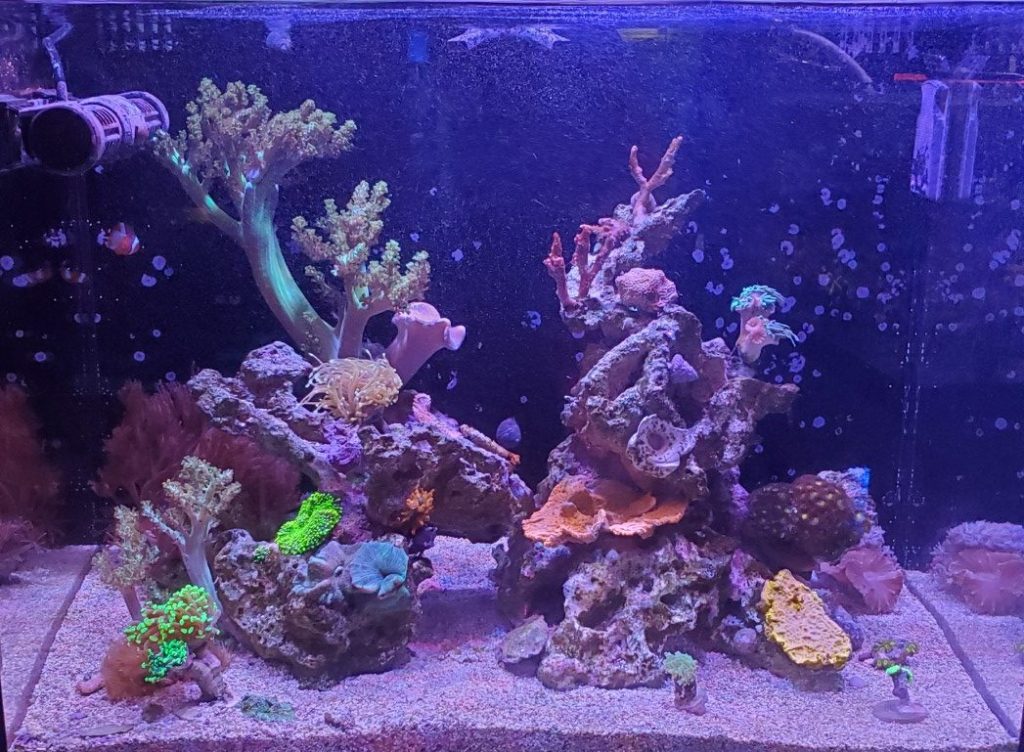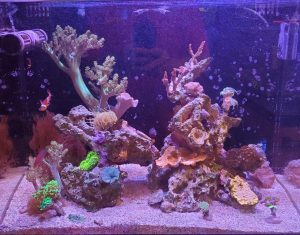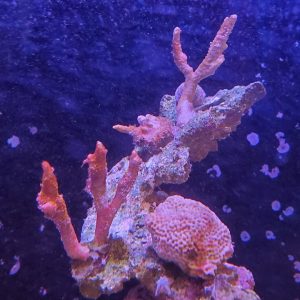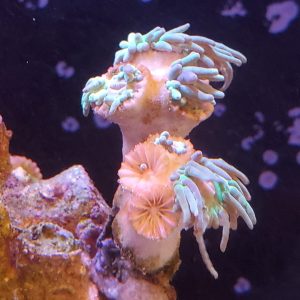
Preface: This Reef Mentoring article series is to document my recommendations to a hobbyist I have been mentoring. I am basically building a reef tank with his setup in my house and maintaining it for a year with weekly hands on sessions.
Since the last update we were able to recover from some typical reef tank issues: cyanobacteria, mysterious fish deaths, and nutrient imbalance. You can revisit that article here to see the solutions we applied. With any reef system there will be growing pains as the system matures and the bioload changes either from growth or new additions.
The “B” Word
The fish and corals have been doing well and stable up to this point. The addition of some new clean up crew members seemed to have brought in a variant of Bryopsis algae. Out of all the nuisance algae Bryopsis has always been the worst to deal with. There are not many natural predators that will both eat bryopsis and are sized for small nano tanks like this Waterbox 30.2.
Round 1 – Manual Removal
Typically the first step is to identify what the nutrient levels are in the system. My nitrates have been in a range between 5-10ppm and phosphates between 0.08-0.10 ppm.
The nutrient levels seem to be at a reasonable level so the only possible action would be manual removal.
- Use fingers to pinch off large algae clumps
- Brush the remaining off with a tooth brush
- Perform a 50% water change while siphoning any loose debris and clean the gravel.
- Replace all the filter floss and carbon.
Round 2 – Herbivores
Natural predators will always be my initial response to algae issues but none of the below seemed to make much of a difference even after some manual removal during maintenance.
- Snails – A slow increase of a variety of snails (Nerites, Astraea, and Mexican turbo snails were currently available) just as I saw initial patches emerge on the rocks
- Short Spine Urchin and Tuxedo Urchin
- Starry Blenny
Round 3 – Chemical hammers
There have been cases where raising magnesium helps counter algae, but not in this case since my magnesium levels are between 1400-1500 ppm at all times anyways. I normally perform water changes between my 510 gallon system into this Waterbox 30.2 every couple of weeks pending the Nitrate and Phosphate tests. For types of blue-green algae gradual daily dosing of 3% hydrogen peroxide have been known to work but not on Bryopsis.
Caution: 3% Hydrogen Peroxide Dosing has many uses. In a display tank it raises ORP as an oxidizer of organic compound in the water and an anti-bacterial agent. It can have detrimental effects on small crustaceans and micro fauna if dosed beyond the recommended safe levels such as 1ml/10gallons. It is also recommended to dose when lights are off since an UV light will decompose hydrogen peroxide down to water and oxygen molecules. Use of 35% Food Grade Hydrogen Peroxide has also been documented but this larger concentration can be intense for most uses. Hydrogen peroxide also improves the efficiency of ferrous materials (GFO) to absorb the phosphates. This can be good and bad since steep drops in phosphates can cause issues such as rapid tissue necrosis on corals. So do your research prior to attempting this method.
Apparently the same batch of snails also added Bryopsis into my main system. Only the smaller tanks that did not have large tangs inhabiting them had shown patches growing. I had no choice but to dose the whole system with Fluconazole.
Fluconazole is an antifungal medication that helps treat bryopsis infestations. As with many chemical treatments there are some risks. I do an annual maintenance treatment to my system. Bryopsis will always show up at some point since I do not have a dedicated quarantine system for everything. The key is to follow the instructions and turn off all skimmers and UV sterilizers, and remove chemical absorbents (activated carbon etc.) from the system to maintain the the proper treatment concentration. At the end of the treatment period the bryopsis slowly turns white and stops growing, and at that point, it will be much easier to vacuum or brush off with a toothbrush. Manually remove whatever remnants there are in the tank. Perform a partial water change and restore all filtration that was turned off for the treatment.
Observations
The fluconazole worked great in the Waterbox 30.2. All the bryopsis disappeared from all the rocks. I wonder if it made it more palatable to the existing clean up crew.
The one negative I did notice was that my alkalinity crept up during the treatment. Normally that is not a good sign since it could mean corals died or are not growing and absorbing these materials. Once all my filtration is back on after a week the alkalinity levels started to slowly drop again.
A second observation was I lost a few corals. A few of my Euphyllia polyps in my main system suddenly had brown jelly disease during the treatment period. Some Duncans and Montipora digitata in the Nano reef also took a dive. It is hard to definitely correlate this to the fluconazole treatment or from nutrient export equipment turned off. I can surmise that nutrients are not being removed from the water column causing a bacterial outbreak. At a hobbyist level this is purely speculation of course, but it has been inconsistent through all the years I have performed this treatment.
- Post Fluconazole Treatment
- Montipora Digitata Impacted
- Duncans also Impacted
Whatever it was that caused the rise in Alkalinity keep in mind the following relationships: If the alkalinity rises too high, it may impact some corals if you over react and drop the Nutrients in the system too fast even in normal conditions. RTN/STN/Tissue recession may occur when you invoke this scenario. As generalized on many forums and video sources, high light intensity/ prolonged photo periods result in higher metabolism. With higher metabolism the corals would require higher levels of dosed elements (alkalinity, calcium, magnesium, and trace elements) and higher nutrient levels to sustain themselves. As an analogy, compare this to many high performing athletes and their dietary intake.
Lessons Learned
- Track water parameters closely during treatments – The next time I decide to perform any chemical treatment I will pay more attention to the alkalinity and nutrient levels to see if the same trends occur. Keep in mind that every coral reacts differently to various treatments. In this case there was no impact to any of the soft corals. For example, I previously treated this system for cyanobacteria with Chemi-Clean with no issues with any coral.
- Keep notes – It is a good practice to keep notes of your observations from each treatment.
- Quarantining invertebrates? Do I treat a smaller QT tank with fluconazole for every batch of clean up crew I buy?
The key is to learn from every experience. I have been in this hobby for over 35 years and there is still much to learn.
This project has reached its half-way point. I agreed to take this on for just 1 year until the owners finalize their next residence. We will see what the remaining months bring!
Happy Reefing!













0 Comments